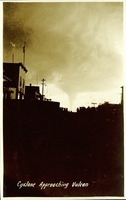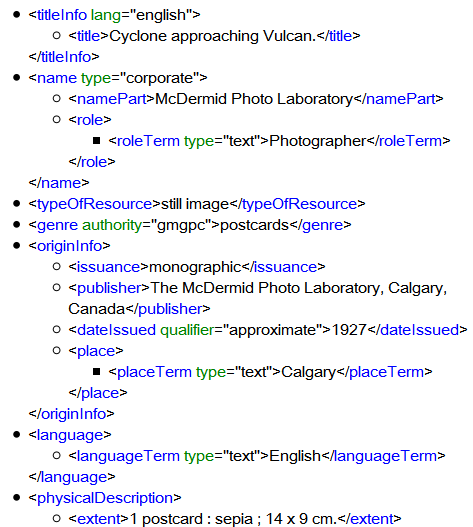About the Collection
 Cyclone approaching
Cyclone approaching
Vulcan, 1927
The Prairie Postcards Collection consists of 14,000+ postcards depicting various aspects of life on the Canadian Prairies from the late 19th through the mid 20th centuries. This initial offering was acquired in two stages, and we will continue to add to it as additional Prairie-themed cards are digitized and described.
The majority of the cards are individuals. However, there are several ‘booklets’, some of which consist of a set of individual cards together in an ‘envelope’ which is a postcard in its own right, others of which consist of a set of smaller cards that are all attached to each other (and to the ‘main’ card) and fold-out. In both cases, each card has been digitized and described separately, but the connection to the rest of the set has been maintained in the record.
The physical collection is housed in the Bruce Peel Special Collections Library and is available to students, staff, and the general public for use within the Library.
A Sampling of Postcards
Metadata
Each digital postcard is accompanied by metadata, which not only describes the item, but aids in overall searching and browsing of the collection.
The metadata for the Prairie Postcard Collection follows the Metadata Object Description Schema (MODS) maintained by the Library of Congress. Several controlled vocabularies have been used, including the Library of Congress Thesaurus for Graphic Materials (TGM), the Library of Congress Authorities, the Canadiana Authorities, and Geographical Names of Canada.
The image below is an example of some of the metadata for a digitized postcard from the Prairie Postcards Collection.

The main metadata elements are:
- Title
- The caption as it appears on the postcard. If there is no caption, a brief, descriptive title is provided and placed in square brackets. Example: Winnipeg Jubilee Parade 1924; [Huskies pulling a sled]
- Names
- Name(s) of printers, photographers, or publishers. Example: Frasch Fotos (Publisher); Gano (Photographer)
- Date
- The date the postcard was issued. It may be taken from the postcard, but in most cases it is estimated based on known events, style of clothing of people depicted, etc. Example: 1924; ca. 1918
- Place
- Place associated with publication or printing of the postcard. Example: Toronto (Ont.); [Wainwright]
- Physical Description
- Categorization of the card as a single or part of a booklet, dimensions (in centimetres), and an indication of colour (black & white, colour, or sepia). Example: 1 postcard : b&w ; 9 x 14 cm.
- Description
- A brief textual explanation of what is depicted on the card. Example: Buffalo calves in Wainwright National Park, Alberta; East from 2nd Avenue. Toronto General Trust and Cenotaph in foreground
- Postmark
- Place and date of the postmark , if present. Example: Chauvin, Alberta, 1935-06-27
- On Front, On Back
- Transcription of any text (other than the caption) on the front of the card, or any text (other than the statement of publication) on the back of the card. Example: Written on front in ms.: What do you think of our hotel here; Written in ms.: The x is [were] our car was the Sat. night we sat eating the potato chips & drinks
- From, To, Address, Message
- Transcription of any hand-written message on the back of the card, if present. (Note: not all messages have been transcribed. See ‘Future Directions’, below, for more detail). Example: From: Uncle B. To: [Master] B.F. Wolstecroft, Dahinda, Sask. "Barry: Will you have a few if I send 'em down? Uncle B."
- Subjects
- Places, topics and named entities (people, organizations, buildings) depicted on the card. Example: Birtle, Manitoba, Canada; Stores & shops; Dinosaurs; Alberta Temple (Cardston, Alta.)
Future Metadata Directions
As noted above, not all of the messages found on cards in the collection have been transcribed, which we hope to address in the future. In addition, we hope to enhance the subject description of cards depicting Aboriginal peoples, places and events using the Canadian Subject Headings (CSH).
We endeavour to be as accurate and thorough as possible when describing these images. If you have any corrections or additional information, please contact us.
Other notes
A special thanks to our fearless metadata crew (Farzaneh Salehi, Tracy Kitagawa, Brian Stearns, Jennifer Hale, and YCW student Rebecca Schramm) and our Quality Assurance team at Winspear Library (Neda Svob, Cliff Wilkinson and Chris Was).
 Alberta Digital Royal
Commissions
Alberta Digital Royal
Commissions Alberta
Folklore and Local History
Alberta
Folklore and Local History Alberta
Folklore and Local History Photographs
Alberta
Folklore and Local History Photographs Atlas
of Alberta Railways
Atlas
of Alberta Railways Educational Resources
Educational Resources Copyright
and Usage
Copyright
and Usage Spot an
error?
Spot an
error? Peel's Roadmap
Peel's Roadmap Questions and Answers
Questions and Answers Related
Websites
Related
Websites